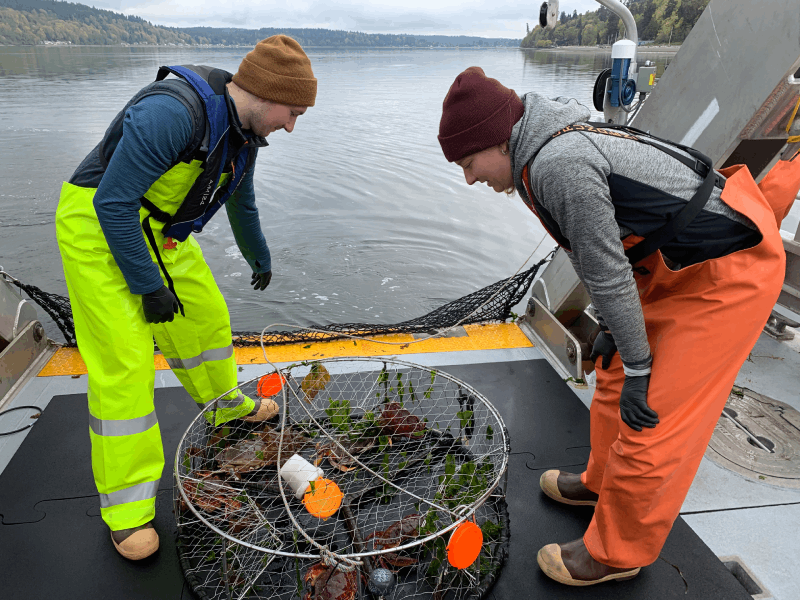Marine Crab Tissue

We monitor seafloor habitats that receive contaminant inputs from combined wastewater and stormwater outfalls (called CSOs for combined sewer overflows), stormwater outfalls, industrial outfalls, and wastewater treatment plant outfalls. The crab we collect from the seafloor are tested for a metals, legacy contaminants (like PCBs and DDTs), and some contaminants of emerging concern (like PFAS or forever chemicals) that are toxic and known to persist in the environment (see parameter table below). We catch Dungeness and red rock crab near public fishing piers and public access points using baited crab pots—both species are consumed by recreational and tribal fishers. Our crab sampling sites are in Seattle at Elliott Bay and Shilshole Bay, Vashon Island at Tramp Harbor, and in Des Moines at Redondo Pier.
In addition to crabs, we sometimes sample other invertebrates that people like to eat, such as squid. We monitored metals and organic contaminants (PCBs, PBDEs, and pesticides) in market squid collected from Elliott Bay and the Redondo Pier in 2016 (click here for report).
More Information
| Contaminants | Description and source | Toxicity - why do we track this? |
|---|---|---|
| Metals | Some metals occur naturally in marine environments, but others enter the Puget Sound from a variety of human sources via stormwater runoff, municipal wastewater, industrial releases, and aerial deposition. | Though some metals are micronutrients, meaning we need them in very small amounts, many metals are also toxic, especially at high concentrations. Copper and zinc can cause a range of toxic effects in fish, including oxidative stress, reduced growth and survival, and disruption of their ability to sense their environment and respond to predators. Other metals, like mercury, lead, and arsenic, in fish tissues can be toxic to humans. Lead and Mercury are toxic to the nervous system while arsenic exposure can cause poisoning symptoms like abdominal pain, vomiting, and diarrhea. Chronic (long-term) exposure to lead and arsenic can cause cancer in humans. |
| PCBs | Polychlorinated biphenyls (PCBs) are man-made, organic chemicals produced in the U.S. for industrial use in transformers and capacitors and are included in or added to products like carbonless copy paper, paint, and caulking, among others. Production of PCBs was banned in 1979 and use substantially declined but they are considered legacy pollutants because they don’t easily break down and persist in the environment. | PCBs are highly toxic and can cause harmful impacts to humans and fish, including cancer and impairments in the immune system, nervous system, hormone production/regulation, and reproduction. PCBs bioaccumulate in fish and biomagnify to high levels in species at the top of the food chain, such as orcas. |
| PBDEs | Polybrominated diphenyl ethers (PBDEs) are man-made organic chemicals that have been used as flame retardants in products for over 30 years. Like PCBs, PBDEs do not break down easily in the environment. Starting in 2007, Washington State passed legislation restricting the use of PBDEs in many household and consumer products. | PBDEs are bioaccumulative and toxic. They can harm multiple organ systems in humans and cause cancer as well as negative impacts to the nervous system and to hormone production/regulation. |
| Organochlorine pesticides | Organochlorine pesticides are synthetic pesticides containing chlorine that were historically used to treat agricultural crops and to control disease carried by insects. Most organochlorine pesticides have been banned in the U.S., but because of their persistence they are still present in the environment today. DDT is an example of one of these. | Organochlorine pesticides are highly toxic compounds that bioaccumulate and are harmful to many different species. DDT accumulates in birds who eat contaminated fish, which can cause eggshell thinning and prevent their young from surviving. This contributed to the listing of Bald eagles (who eat salmon) as an endangered species in 1967. |
| PFAS | Per-and-polyfluoroalkyl substances (PFAS) are man-made chemicals containing fluorine that are used today in many industrial and consumer products meant to be resistant to water, grease, and stains, such as Teflon and Gore-Tex. PFAS don’t breakdown easily in the environment and have been found in human blood and breast milk, drinking water, soils, air, and animal tissues. | PFAS can bioaccumulate in fish tissues and have been detected in the tissues of salmon and Orca. Toxicity has been reported in humans, fish, rats, amphibians, and birds. PFAS toxicity can lead to cancer and impact immune function, thyroid function, liver and kidney health, reproduction, and development of young. |
| PAHs | Polycyclic aromatic hydrocarbons (PAHs) are ring-like molecules made up of carbon and hydrogen that are found in fossil fuels and produced from their combustion. Wood/organic waste burning, and vehicle exhaust are two large sources of human-produced PAHs. Larger PAHs with more aromatic rings are harder to break down in the environment than smaller PAHs. | Though fish don’t bioaccumulate PAHs because their liver enzymes break PAHs down for excretion, we can measure the products of metabolism in their bile to track their exposure to PAHs. This is important because PAHs can cause cancer in fish and negatively impact their development, immune system, and hormone-regulation systems. |
Access Data
Contact wlrtoxicology@kingcounty.gov for data and information about the most recent quality control.
Documentation
Learn more about our program by reading relevant reports and presentations.
Contact us with any questions or access additional resources in the Science Section Library.

 Translate
Translate